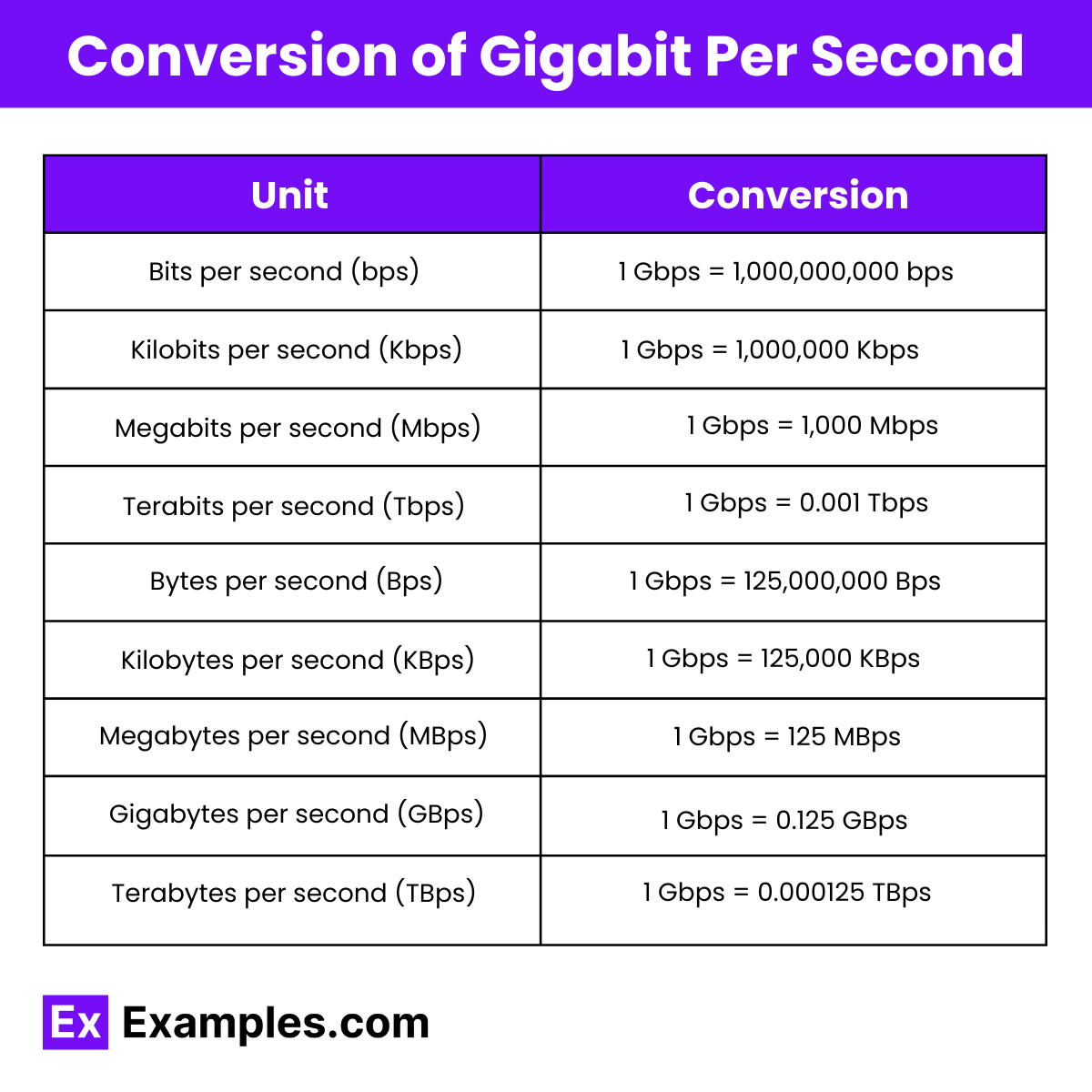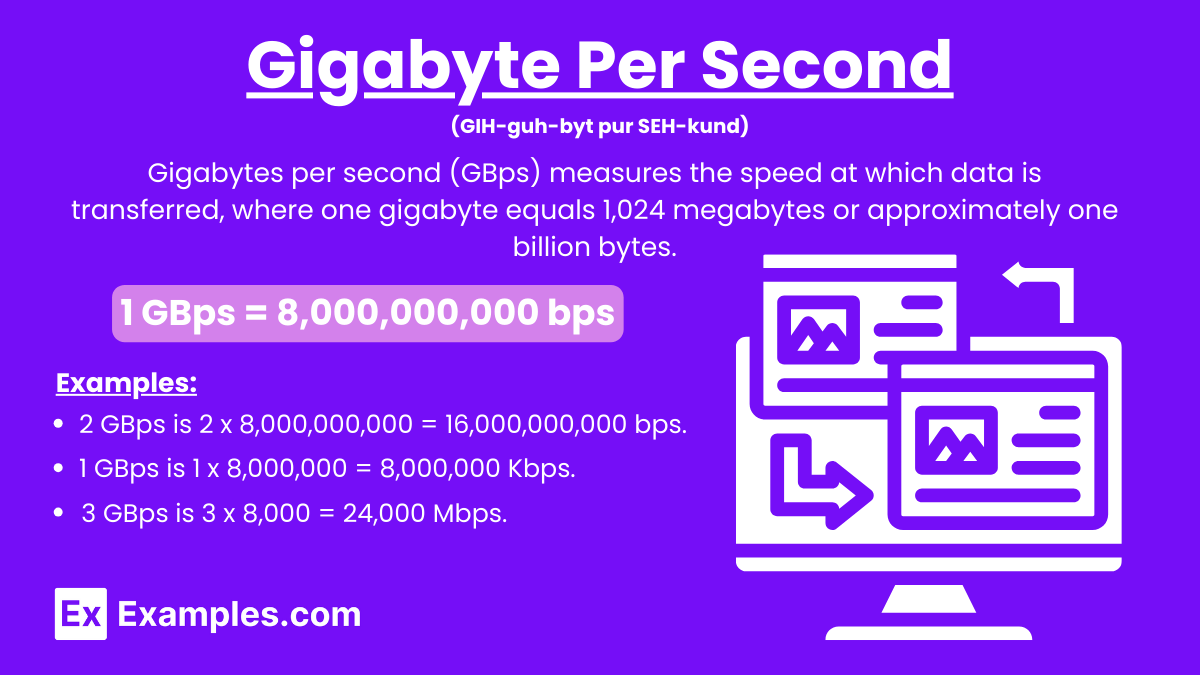15+ Gigabyte Per Second Examples
Gigabytes per second (GBps) is a unit of measurement for data transfer rate, indicating the number of gigabytes of data transmitted or received each second. One gigabyte is equivalent to 1,024 megabytes, 1,048,576 kilobytes, or 1,073,741,824 bytes. This unit is commonly used to quantify the speed of data transfer in high-capacity networks, storage devices, and high-performance computing systems. Higher GBps values represent faster data transfer rates, which are essential for efficiently handling large volumes of data. In different contexts, other units of speed are used, such as foot per second, meter per second, and miles per second, to measure the velocity of objects. Each of these units provides a specific way to understand the rate at which something moves over a given second, whether it’s data through a network or physical objects in motion.
What is Gigabyte Per Second?
Gigabytes per second (GBps) measures the speed at which data is transferred, where one gigabyte equals 1,024 megabytes or approximately one billion bytes. This unit is used to describe data transfer rates in high-performance networks, storage devices, and computing systems. A higher GBps value indicates faster data transmission, crucial for efficiently handling large datasets and high-demand applications. Understanding units of measurement is essential in various fields, including data transfer rates. Different measurement units are used to quantify speed and length, such as meters or feet. A measurement chart can help convert between these units, ensuring accuracy and clarity in communication.
Examples of Gigabyte Per Second
- Downloading high-definition movies
- Streaming 4K videos
- Transferring large datasets between servers
- Backing up entire systems to cloud storage
- Running virtual reality (VR) applications
- Loading complex video games
- Streaming live eSports events
- Transferring high-resolution images
- Synchronizing large multimedia libraries
- Downloading extensive software updates
- Conducting scientific simulations
- Streaming high-quality video conferences
- Accessing large-scale databases
- Transferring data for machine learning models
- Streaming real-time security camera feeds
Gigabyte Per Second Formula
The formula to calculate the data transfer rate in gigabytes per second (GBps) is:
Data Transfer Rate (GBps) = Time Taken (Seconds)/Total Data Transferred (Gigabytes)
Steps to Use the Formula
- Determine the Total Data Transferred
- Measure the total amount of data transferred.
- Convert this amount to gigabytes (GB) if it is in another unit (e.g., bytes, kilobytes, megabytes).
- Measure the Time Taken
- Measure the total time taken for the data transfer in seconds.
- Apply the Formula
- Divide the total data transferred (in gigabytes) by the time taken (in seconds) to get the data transfer rate in gigabytes per second (GBps).
Conversion of Gigabyte Per Second

| Unit | Conversion |
|---|---|
| Bits per second (bps) | 1 GBps = 8,000,000,000 bps |
| Kilobits per second (Kbps) | 1 GBps = 8,000,000 Kbps |
| Megabits per second (Mbps) | 1 GBps = 8,000 Mbps |
| Gigabits per second (Gbps) | 1 GBps = 8 Gbps |
| Terabits per second (Tbps) | 1 GBps = 0.008 Tbps |
| Bytes per second (Bps) | 1 GBps = 1,000,000,000 Bps |
| Kilobytes per second (KBps) | 1 GBps = 1,000,000 KBps |
| Megabytes per second (MBps) | 1 GBps = 1,000 MBps |
| Terabytes per second (TBps) | 1 GBps = 0.001 TBps |
Understanding how to convert data transfer rates to other common units is crucial when dealing with different data speeds, whether you’re configuring network settings, comparing internet speeds, or ensuring accurate data rates for projects. Here’s a straightforward guide to converting data transfer rates to and from other common units:
Gigabytes per second (GBps) to Bits per second (bps)
Multiply the GBps value by 8,000,000,000 to convert to bps.
Example: 2 GBps is 2 x 8,000,000,000 = 16,000,000,000 bps.
Gigabytes per second (GBps) to Kilobits per second (Kbps)
Multiply the GBps value by 8,000,000 to convert to Kbps.
Example: 1 GBps is 1 x 8,000,000 = 8,000,000 Kbps.
Gigabytes per second (GBps) to Megabits per second (Mbps)
Multiply the GBps value by 8,000 to convert to Mbps.
Example: 3 GBps is 3 x 8,000 = 24,000 Mbps.
Gigabytes per second (GBps) to Gigabits per second (Gbps)
Multiply the GBps value by 8 to convert to Gbps.
Example: 4 GBps is 4 x 8 = 32 Gbps.
Gigabytes per second (GBps) to Terabits per second (Tbps)
Multiply the GBps value by 0.008 to convert to Tbps.
Example: 5 GBps is 5 x 0.008 = 0.04 Tbps.
Gigabytes per second (GBps) to Bytes per second (Bps)
Multiply the GBps value by 1,000,000,000 to convert to Bps.
Example: 1 GBps is 1 x 1,000,000,000 = 1,000,000,000 Bps.
Gigabytes per second (GBps) to Kilobytes per second (KBps)
Multiply the GBps value by 1,000,000 to convert to KBps.
Example: 2 GBps is 2 x 1,000,000 = 2,000,000 KBps.
Gigabytes per second (GBps) to Megabytes per second (MBps)
Multiply the GBps value by 1,000 to convert to MBps.
Example: 3 GBps is 3 x 1,000 = 3,000 MBps.
Gigabytes per second (GBps) to Terabytes per second (TBps)
Multiply the GBps value by 0.001 to convert to TBps.
Example: 4 GBps is 4 x 0.001 = 0.004 TBps.
Importance of Gigabyte Per Second
Just as KBps is used to measure data transfer rates, other units of measurement like yard, centimeter, and millimeter are used to quantify length in various contexts. Using a measurement chart helps convert between these units, providing clarity and precision in different fields of study and application.
- High-Speed Data Transfers: Ensures quick movement of large files.
- Efficient Storage Solutions: Improves read/write speeds of storage devices.
- Enhanced Network Performance: Supports high-speed data flows in networks.
- Real-Time Data Processing: Enables seamless real-time applications.
- Improved User Experience: Reduces load times and buffering.
- Scalability for Businesses: Supports growth and larger datasets.
- Support for High-Bandwidth Applications: Ensures smooth operation of advanced technologies.
- Data Center Efficiency: Enhances data handling in large-scale environments.
- Competitive Advantage: Delivers faster, more reliable services.
- Future-Proofing Technology: Prepares for future data demands.
Where do you use of Gigabyte Per Second
- Virtualization and Virtual Machines: In virtualized environments, GBps is used to measure data transfer rates between virtual machines (VMs) and physical storage. High data transfer rates are essential for maintaining performance and efficiency in virtualized data centers.
- Network Backbone and Interconnects: Network backbones and interconnects between large-scale data centers or within supercomputers use GBps to measure data transfer rates. This ensures that data can be transmitted at very high speeds, supporting large-scale data transfer and communication.
- Scientific Research and Big Data: Scientific research projects that involve big data, such as genomic research, climate modeling, and particle physics, use GBps to measure data transfer rates. High data transfer rates are necessary for processing and analyzing large datasets in a timely manner.
- Medical Imaging and Healthcare: Healthcare facilities that handle high-resolution medical imaging, such as MRI, CT scans, and digital pathology, use GBps to measure data transfer rates. Fast data transfer ensures that large imaging files can be quickly accessed and analyzed for diagnostic purposes.
- Gaming and Virtual Reality (VR): High-end gaming systems and VR platforms use GBps to measure data transfer rates. This ensures that large game files, textures, and VR environments can be loaded and rendered quickly, providing a seamless gaming experience.
- Financial Services and High-Frequency Trading: Financial institutions that engage in high-frequency trading and other data-intensive financial services use GBps to measure data transfer rates. High-speed data transfer is critical for executing trades and processing financial transactions with minimal latency.
- Autonomous Vehicles and IoT: Autonomous vehicles and large-scale IoT implementations use GBps to measure data transfer rates for transmitting sensor data, high-resolution maps, and other critical information in real-time. This supports the efficient operation and decision-making processes of autonomous systems.
- Telecommunications Networks: Advanced telecommunications networks, including 5G infrastructure and fiber-optic networks, use GBps to measure data transfer rates. This ensures ultra-fast internet speeds and reliable communication services for a wide range of applications.
- Content Delivery Networks (CDNs): CDNs that distribute large volumes of content, such as streaming video, software downloads, and online gaming updates, use GBps to measure data transfer rates. High data transfer rates ensure that content is delivered quickly and efficiently to users worldwide.
How does GBps differ from Gbps?
GBps measures gigabytes per second, while Gbps measures gigabits per second. One gigabyte equals eight gigabits.
What factors affect data transfer speeds in GBps?
Factors include hardware capabilities, network bandwidth, data encoding, and system performance.
How is GBps used in computing?
GBps measures data transfer rates in high-speed networks, storage devices, and data centers.
What is the significance of higher GBps?
Higher GBps speeds enable faster data transfers, improving system performance and efficiency in data-intensive applications.
Can GBps be used to measure internet speed?
Yes, but internet speeds are usually measured in megabits per second (Mbps) or gigabits per second (Gbps).
What hardware supports high GBps speeds?
High-speed SSDs, fiber optic networks, and advanced processors support high GBps speeds.
What are typical applications for high GBps speeds?
Applications include video streaming, data backup, cloud computing, and virtual reality.
What is the role of GBps in data centers?
In data centers, GBps measures storage, network, and server data transfer rates, impacting overall performance.
How do you test data transfer speed in GBps?
Use benchmarking tools and software to measure data transfer speed in GBps.
What influences GBps speeds in networks?
Network architecture, cabling quality, and traffic congestion influence GBps speeds.


